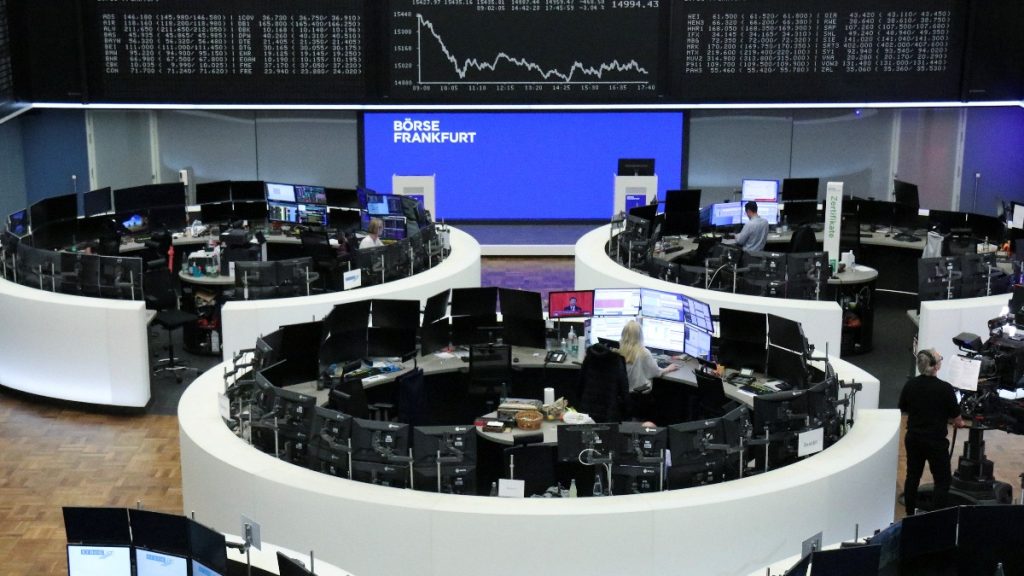
Global shares slid on Tuesday as a brewing U.S. banking crisis prompted investors to downgrade their expectations for interest rate hikes, even ahead of key inflation data later in the day.
As recently as a week ago, investors were just recovering from a reality-check that prompted many to assume that rates around the world were likely to head much higher and stay there for longer than previously expected.
In under a week, three U.S. banks have collapsed. It has been the failure of technology-sector lender Silicon Valley Bank (SVB) that has rattled investor confidence and triggered a rush into safe-haven assets like bonds and gold.
Banking stocks around the world have shed hundreds of billions of dollars in value in a matter of days, while the government bond market has seen one of its biggest rallies in decades.
The MSCI All-World index was down 0.5% on the day, largely due to steep declines across Asian equity markets, while in Europe shares entered a third day of declines, down 0.1%.
Short-dated U.S. Treasury yields rose 14 basis points to around 4.17%, but given that on Monday they posted their largest one-day drop since 1987, the rise on Tuesday still left yields at their lowest in six months.
Many have drawn parallels to the 2008 financial crisis, when indicators of financial market stress shot up and equities crumbled. But Societe Generale chief currency strategist Kit Juckes said the current situation was far more like the U.S. savings and loans crisis of the 1980s, in which hundreds of smaller banks folded when the Federal Reserve jacked up interest rates to control inflation.
SVB, which was the 16th biggest U.S. bank at the end of last year, is the largest lender to fail since 2008. Specifics of the tech-focused bank’s abrupt collapse are still something of a jumble, but the sharp rise in Fed rates in the last year, which tightened financial conditions in the startup space in which it was a notable player, seemed front and centre.
“I don’t think this is a systemic global banking issue. If it’s an issue, it’s an issue of a smaller but less-regulated bank that has been growing very fast on the back of being less regulated in a stable environment that has turned nasty,” Juckes said.
“When I look at (the savings and loans crisis), we had a very mild recession, even though we were worried about it at the time. We had a very big interest rate reduction after a very big interest rate increase,” he said. “(SVB) seems very unlikely to have very big systemic implications, particularly when U.S. authorities have come in so quickly to start tackling it.”
Overnight the VIX volatility index, nicknamed Wall Street’s “fear gauge”, neared six-month highs and other indicators of market stress showed early signs of strain. An index of bond market volatility – the ICE BofA MOVE index – had hit a 14-year high by Monday’s close.
WATCH THE PLUMBING
The S&P banking index fell 7% on Monday, its largest one-day drop since June 2020. Shares in non-U.S. lenders have come under intense pressure and a number of indicators of banking sector credit risk are showing signs of stress.
“Interbank markets have become stressed,” said Damien Boey, chief equity strategist at Sydney-based investment bank Barrenjoey.
“Arguably, liquidity measures should have stopped these dynamics, but Main Street has been watching news and queues – not financial plumbing,” he said.
Yields on government bonds from the U.S. to Germany and Japan have dived in the last week. German two-year yields, which fell by the most at least since reunification in 1990, while Japanese yields have fallen by the most in decades.
Elsewhere, the dramatic re-pricing of U.S. rate expectations has knocked 1.5% off the value of the U.S. dollar in the last week, which in turn has helped encourage a push into gold, a traditional safe haven that has gained 5% in the last week alone to trade around $1,900 an ounce.
The dollar gained some respite on Tuesday and was last up 0.7% against the yen at 134.11 yen and up 0.3% against the euro at $1.070.
Data at 1230 GMT on U.S. consumer inflation had been a set piece for markets prior to the failure of SVB, but given the volatility, Tuesday’s figures may have little impact on expectations for the Fed’s meeting next week.
“I always thought that with inflation where it was, that central banks would keep hiking until they broke something, which was especially likely with the yield curve so inverted. Now they have broken something, is that enough for a pause? Much will depend on whether markets and contagion risk can calm quickly enough,” Deutsche Bank’s Jim Reid said.
Nerves have capped oil prices, with Brent crude futures slipping below $80 a barrel.
LONDON (Reuters)
Inside Telecom provides you with an extensive list of content covering all aspects of the Tech industry. Keep an eye on our News section to stay informed and updated with our daily articles.